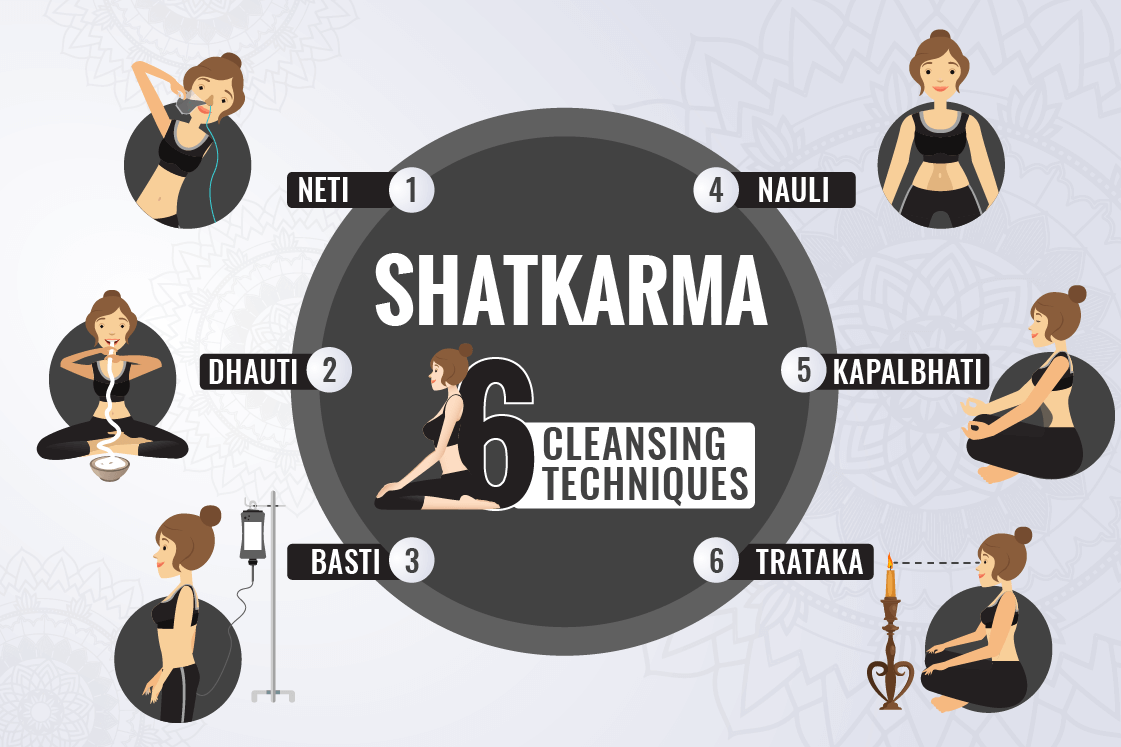As a house stands firmly on its foundation, the same way, in the yogic journey our body needs a strong foundation that becomes the base for whole practices of yoga. The base here we talking for our body is the cleansing of our internal system of organs. In the yogic tradition, this cleansing is known as Shatkarma or Shat kriyas.
Modern science says 1, our internal organ comprised of 11 major systems includes circulatory, respiratory, digestive, excretory, nervous, and endocrine systems. To make sure the healthy & proper functioning of the body as a whole, the cleansing of organ systems is very important on a regular basis.
Traditionally, there are 6 method yogis used for cleansing of internal organs for a healthy body is called as Shatkarma.
Summary of Contents
Shatkarma or Shat Kriya
Shatkarma is a set of 6 preparatory practices used by ancient yogis to purify the body internally, thus prepare them for higher practices of asana & pranayama.
The term Shatkarma is originally taken from the Sanskrit language, which has 2 root words: Shat & Karma.
Shat means “Six” & karma here is referred to as “Action performed to achieve some desired results“.
Shatkarma also called Shat Kriya as it’s the Hindi translation of the term Shatkarma (Karma = Kriya).
Why Purify Body? Importance of Shatkarma
Consider the human body as a computer system. The external body which we can touch or see is like the hardware of the computer system while the internal body works as a software.
External body or hardware is easy to come in contact thus it gets purified through daily routine activities like wash, bath & brushing, etc. While the inner body organs come in contact with the external matters regularly ( through food, vision, touch, smell) and don’t have any specific routine activities to get purified.
- It is important for a yoga practitioner to purify their inner body organs from time to time so as to make sure the proper working of yogic practices on the body. Shatkarma removes impurities of internal body2 organs which got accumulated by regular intake of external matter through different sensory organs.
- To make sure the proper flow of Prana (life force) Shatkarma ensures there isn’t any physical/mental knot present in Nadis. Shatkarma, especially Kapalbhati & Nauli balances Prana flow within two important Nadis i.e. Ida & Pingala.
- Usually, our mind is cluttered from many unwanted thoughts which in the yogic language are called Vrittis. By the practice of Shatkarma (more especially trataka), we can bring a state of steadiness in mind.
There are mainly 2 traditional texts “Hatha Yoga Pradipika” & “Gheranda Samhita” that have described Shatkarma in a detailed manner. Whereas both texts belong to the teachings of Hatha Yoga, their idea of performing Shatkarma is completely different.
Shatkarma In Hatha Yoga Pradipika (HYP)
Swami Swatmarama, Author of classical Hatha Yoga text HYP has prescribed the practice of Shatkarma only for these people:
- People who have excessive fat or mucus accumulation in the body
- When there is an imbalance comes in doshas
Swami Swatmarama clearly stated that if 3 doshas lie in correct proportion & no extra fat accumulated in the body, Yoga Sadhak (practitioner) has no need to practice Shatkarma. However, learning practices of Shatkarma is necessary so one can practice it when needed.
Apart from this, the sequence of individual practice of Shatkarma in HYP is mentioned in this verse:
Dhautirbastistathā netistrātakam naulikam tathā Kapālabhātiśchaitāni shatkarmāni prachakshate – HYP 2.23
Meaning – Dhauti, Basti, Neti, Trataka, Nauli and Kapalabhati are called shatkarma.
Shatkarma In Gheranda Samhita
Sage Gheranda is another foremost author of Hath Yoga teachings who emphasized to practice Shatkarma at the very first stage of yoga.
The Yoga Sage Gheranda propagated is also called Ghatastha Yoga which has 7 limbs, in contrast to eight-limbed yoga that came from Yoga Sutra. 7 Limbs mentioned in Gheranda Samhita are:
- 1st limb – Shatkarma – for purification of body
- 2nd limb – Asana – Strengthens the body
- 3rd limb – Mudra – Bring Steadiness in body
- 4th limb – Pratayahara – Withdrawal of senses from the outer world
- 5th limb – Pranayama – Bring lightness in the body
- 6th limb – Dhyana – for inner perception
- 7th limb – Samadhi – the ultimate goal of yoga
According to Sage Gheranda, our body & mind is like a vessel (combinedly called as Ghata) that carry our soul & characteristics Gunas as water inside a vessel.
Ghatastha Yoga firstly aims to purify the body or vessel that carries a soul, through 6 purification techniques contains in Shatkarma. This purification of body & mind is termed in Gheranda Samhita as Ghata Shuddhi.
Thus, the practice of Shatkarma is important for every person who has just begin the journey of yoga as per Gheranda Samhita.
The sequence of 6 practices of Shatkarma according to Sage Gheranda is also a little different than the HYP sequence. Here shatkarma sequence is:
- Dhauti
- Basti
- Neti
- Nauli
- Trataka
- Kapalbhati
1. Dhauti – Cleansing of Digestive Tract

Dhauti is the first Shatkarma that literally translates as ‘washing‘. In this kriya, different techniques are used to flush out toxic & undigested food particles from internal organs.
Some common types of Dhauti are:
- Vamana Dhauti – Drinking a large quantity of lukewarm water and then vomit it out to removes extra mucus from the food pipe. Also called Kunjal kriya.
- Vastra Dhauti – In this kriya, a clean muslin cloth drowned in tepid water is swallowed & held in the stomach for a few minutes. Then it’s pulled out from mouth end that brings out impurities intestinal tract.
Some other simples techniques to perform Dhauti are Danta (teeth) dhauti, Jihva (tongue) Dhauti & Karna (ear) Dhauti.
The mechanism of Dhauti helps the internal organ system to work efficiently & remove excess mucus from the stomach. Other than this, consistent practice of dhauti kriya balances the Kapha, Pitta & Vata dosha in our body.
2. Basti – Cleansing of Large Intestine
Basti is second in the sequence of shatkarma that treats almost 50% of abdominal diseases.
It directly works on the purification of the central organ of the body called colon (large intestine) that nourishes almost all tissues of body.
Unlike enema which cleans only lower 8 to 10 inches of colon, Basti purifies the whole colon system to the rectum (attached to the anus). The colon is a long tube-like organ in the lower belly that removes water from digested food and is mostly disturbed by solid waste (feces).
Types of Basti
Basti is basically two types based on the procedure of practices: Sthala Basti and Jala Basti.
In both techniques, water is drawn in through anus in the large intestine and then abdominal muscles are churned while holding water inside. After churning, water expelled out through the anus.
3. Neti – Cleansing of Nasal Passages

Neti is the third Shatkarma that deals with purifying nasal cavities from accumulated impurities. it’s very important to clear the nasal cavities as it’s the pathway to Prana we take through breathing.
Breathing works like fuel to charge up the human body. If the fuel (breathing) is dirty by any reasons it can make us sick. unclean nostrils are could be one of the main reasons for irregular breathing.
Neti Shatkarma is the exercise intended for purification of nostrils by the various techniques.
Types of Neti
Neti is basically of 2 types, based on their procedure.
- Jala Neti – In this neti, Jala (water) is used as a cleaning tool to remove the impurities of nostrils. Using the neti pot, water is poured in through one nostril & then under the effect of gravity, it’s expelled out another nostril. Water that comes out from other nostril removes impurities from nasal pathways.
- Sutra Neti – In this neti, a rubber thread (sutra) is used to massage the nasal pathways in such a manner that it opens any blockages present in nostrils.
4. Trataka – Cleansing of Eyes

Trataka Shatkarma is an eye exercise that involves steady and continuous gazing of eyes at any reference point. The reference point in the trataka practice could be any external object. The most common object used in Trataka for reference point is an Illuminated Candle.
Among 6 shatkarma, trataka is known for its simple procedure. Consistent & correct practice of trataka increases concentration power and purifies the mind from fluctuated thought patterns.
Types of Trataka
Base on the reference thing to gaze upon, whether you take an external object or internal point, trataka can be classified into 2 categories.
- Internal Tratak is when the focus is kept on the trikuti or Third eye (a place between eyebrows) inward or upward. Internal trataka helps to awaken the third eye or Ajna chakra.
- External Tratak is the practice of gazing on some external objects continuously. External objects could be anything literally which gives you pleasure hence easy to forcefully gaze on that.
5. Nauli – Cleansing of Abdominal Organs

In Nauli Shatkarma, the movement of the lower abdominal muscle is ensured that stimulate the digestive fire.
It is a necessary yogic kriya that maintains movement in all muscles of the body. Like flowing water is a sign of its purity, in the same way, Nauli practice purifies the liver, spleen, urinary bladder, pancreas, gall bladder, and the intestines by its massaging effect. When all these internal organs regularly movements, the practitioner’s digestion system and appetite improve.
In Nauli kriya, rectus abdominis or abs muscles are isolated either left or right or at middle of the linea alba (anterior wall in the abdomen).
Types of Nauli
On taking linea alba as a middle reference, the isolation of abs muscles on either side of it classifies Nauli into 3 types.
- Madhya Nauli – When left and right both sides abs muscles concentrated at the center wall or linea alba
- Vama Nauli – When both abs muscles are aligned left side from center wall.
- Dakshina Nauli – When both abs muscles are aligned right side from the center wall.
6. Kapalbhati – Cleansing of Frontal Lobes

Kapalbhati is the last Shatkarma that works on improving the functioning of the brain. Because kapalbhati practiced by yoga practitioners as breathing techniques so it’s also known by Kapalabhati pranayama. In kapalbhati, abdominal wall rapidly draws in and out in conjunction with breathing.
Here, in Kapalbhati pranayama, the breathing is quite different from normal breathing. In normal breathing,
- Inhale is active (more focused) while the exhale is passive (less focused).
In Kapalbhati breathing,
- Exhale is active (more focused) while the inhale is passive (less focused).
By emphasizing more on exhaling as compare to inhaling, kapalbhati expels more impurities out in the form of CO2 gas.
Precautions of Shatkarma
- Practice Under Supervision of an expert
Practicing any of 6 Shatkarma needs expertise in that particular kriya, so it’s mandatory to have theoretical as well as practical knowledge. Hence, it’s advised to a beginner to do these kriyas under the supervision of an expert guide.
- Shatkarma Isn’t an Everyday Practice
Most people aren’t aware of the fact that Shatkarma is never advised by ancient yogis to perform daily like asana, pranayama & other disciplines of yoga. It should be practiced weekly or monthly basis depends upon how well your internal organ system works.
- Use Clean & Sterile Equipments
While doing Shatkriya make sure neti pot, water, rubber thread, cotton cloth & other equipment are clean and sterile. The purpose of these yogic activities is to clean your body from its core level so the material you are using that should also be clean.
- Pregnant Women Shouldn’t Practice It
At the time of pregnancy, it is better to avoid doing Shatkriya. If one really wants to do it then she can perform Jalneti and Trataka. Other kriyas may affect the health of the fetus as they are connected with the movement or cleansing of the stomach.
- Lighten Up Your Diet
6 Shatkarmas are really vigorous practices for your internal organs system. Until you lighten up your diet, don’t practice Shatkarma as it’ll overwork your organ system & can lead strain in it.
- Keep Calm While Practicing Shatkarma
If anybody wants to be a master in Shatkriya then make sure don’t hurry while doing Shatkriya. Any kind of hustle in Shatkarma practice can hurt your internal organs system.
Benefits of Shatkarma
- As Shatkarma purifies the internal body, our external organs system also started working well. Thus, it balances the internal & external organ systems.
- The series of these kriyas helps to balance the Tri Doshas of a human being. There are Three Doshas in every human being, if there is any kind of imbalance in any of these Doshas then the body will not function properly. So Shat Kriya helps the Doshas to be in a perfect ratio.
- Shatkarma is helpful to channelize the flow of Prana in Nadis. It helps to clean the blockages of Nadis and thus Prana move without any obstacle inside the body.
- The kriyas are helpful for the connectivity of the mind, soul, and body. As all the channels are cleansed by these kriyas then all the pathways are open and then all those yogic activities connect your mind boy ad soul.
- Shatkarma is helpful in the development of the immune system. If our Immune system is strong and healthy then it helps fight many diseases. So when a being is cleansed from its core that means its base has been cleansed as well. Hence in this manner, the immune system is cleansed as well.
- Physical aging and Biological aging are two different aspects. When our body isn’t clean then it brings physical aging that is pretty earlier from the Biological aging. Shatkriya helps to retarded Physical aging and helps to maintain biological aging.
- It helps to increase awareness of a human being at different levels, at the physical level, psychological level, emotional level, spiritual level, and intellectual level.
References
The original content was published at Fitsri




Great article! I loooove yoga. Anyone interested in this stuff should definitely check out the book Everyday Roots. It teaches you how to replace all the toxic chemicals in your life with healthy organic alternatives. Its completely changed my life and how I feel everyday! 🙂
Keep up the great content!
where in India they do this , I have been to some Ayurveda hospital in Kerala they don’t do It .I want to do it for my 15 yr old son .Please give contact where they do it …..do you know any place in south India which does it .Thank You
I might help you. feel free to ask.